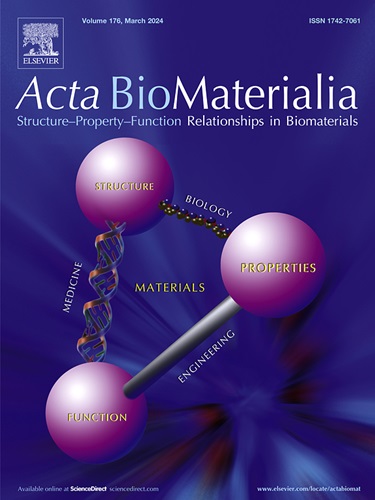Recombinant keratin: Comprehensive review of synthesis, hierarchical assembly, properties, and applications
IF 9.4
1区 医学
Q1 ENGINEERING, BIOMEDICAL
引用次数: 0
Abstract
Keratin has gained attention for its remarkable mechanical properties, thermal stability, and beneficial biological properties, such as promoting hemostasis and wound healing. Traditionally, keratin has been extracted from natural sources, including human hair, wool, and feathers, and processed into biomaterials, including films, hydrogels, and nanoparticles, primarily for biomedical applications. However, extraction methods often result in heterogeneous keratin mixtures with residual impurities and structural degradation due to harsh purification conditions, complicating efforts to understand how specific keratins and their hierarchical assemblies contribute to desired material properties. Recombinant keratin technology addresses these challenges by enabling the synthesis of individual keratin types with high purity and batch-to-batch consistency. These advancements facilitate studies on how individual and combined keratins at various assembly stages![]() from molecular components and heterodimers to intermediate filaments (IFs) and IF networks
from molecular components and heterodimers to intermediate filaments (IFs) and IF networks![]() impact material properties. Moreover, this technology allows for precise genetic modifications, potentially leading to engineered keratin variants with tailored characteristics for targeted applications. Despite these advantages, translating recombinant keratin into practical applications requires overcoming key manufacturing challenges, such as optimizing large-scale production and improving purification efficiency. This review presents the current state of recombinant keratin research by highlighting its advancements and exploring current biomaterial applications. While its applications remain limited compared to extracted keratin at this early stage, its potential offers future opportunities for extending its use in advanced material design and beyond biomedical fields.
impact material properties. Moreover, this technology allows for precise genetic modifications, potentially leading to engineered keratin variants with tailored characteristics for targeted applications. Despite these advantages, translating recombinant keratin into practical applications requires overcoming key manufacturing challenges, such as optimizing large-scale production and improving purification efficiency. This review presents the current state of recombinant keratin research by highlighting its advancements and exploring current biomaterial applications. While its applications remain limited compared to extracted keratin at this early stage, its potential offers future opportunities for extending its use in advanced material design and beyond biomedical fields.
Statement of significance
Keratin and keratinized structures provide essential protection to tissues against mechanical stress and environmental damage, serving as foundational elements across diverse biological systems. This review discusses advancements in recombinant keratin technology, enabling high-purity, reproducible synthesis with controlled composition modifications that effectively overcome the limitations of traditional extraction methods. The innovations deepen our understanding of hierarchical assembly in keratin structures across various length scales, along with their reinforcing mechanisms and mechanical and biofunctional properties. These insights lay the groundwork for biomaterials tailored to regenerative medicine, wound healing, and other biomedical applications. By focusing on the unique capabilities of recombinant keratin, this review offers a valuable resource for future advancements in high-performance biomaterials across biomedical and biotechnological fields.

重组角蛋白:合成、分层组装、性质和应用的综合综述。
角蛋白因其卓越的机械性能、热稳定性和有益的生物学特性(如促进止血和伤口愈合)而受到关注。传统上,角蛋白是从天然来源中提取的,包括人的头发、羊毛和羽毛,并加工成生物材料,包括薄膜、水凝胶和纳米颗粒,主要用于生物医学应用。然而,由于严苛的纯化条件,提取方法通常会导致含有残留杂质和结构降解的异质角蛋白混合物,这使得了解特定角蛋白及其分层组合如何有助于所需材料特性的工作复杂化。重组角蛋白技术通过能够合成具有高纯度和批间一致性的单个角蛋白类型来解决这些挑战。这些进展有助于研究单个和组合角蛋白在从分子组分和异源二聚体到中间细丝(IF)和IF网络的不同组装阶段如何影响材料性能。此外,这项技术允许精确的基因修饰,有可能导致针对目标应用量身定制特征的工程角蛋白变体。尽管有这些优势,但将重组角蛋白转化为实际应用需要克服关键的制造挑战,例如优化大规模生产和提高纯化效率。本文综述了重组角蛋白的研究现状,重点介绍了其进展,并探讨了当前生物材料的应用。虽然与早期提取的角蛋白相比,它的应用仍然有限,但它的潜力为其在先进材料设计和生物医学领域以外的应用提供了未来的机会。重要意义:角蛋白和角化结构为组织抵抗机械应力和环境损伤提供了必要的保护,是多种生物系统的基础元素。本文综述了重组角蛋白技术的进展,使高纯度、可重复的合成与控制组合修饰有效地克服了传统提取方法的局限性。这些创新加深了我们对角蛋白结构在不同长度尺度上的分层组装的理解,以及它们的强化机制和机械和生物功能特性。这些见解为再生医学、伤口愈合和其他生物医学应用量身定制的生物材料奠定了基础。本文综述了重组角蛋白的独特功能,为未来生物医学和生物技术领域高性能生物材料的发展提供了宝贵的资源。
本文章由计算机程序翻译,如有差异,请以英文原文为准。
求助全文
约1分钟内获得全文
求助全文
来源期刊

Acta Biomaterialia
工程技术-材料科学:生物材料
CiteScore
16.80
自引率
3.10%
发文量
776
审稿时长
30 days
期刊介绍:
Acta Biomaterialia is a monthly peer-reviewed scientific journal published by Elsevier. The journal was established in January 2005. The editor-in-chief is W.R. Wagner (University of Pittsburgh). The journal covers research in biomaterials science, including the interrelationship of biomaterial structure and function from macroscale to nanoscale. Topical coverage includes biomedical and biocompatible materials.
 求助内容:
求助内容: 应助结果提醒方式:
应助结果提醒方式:


